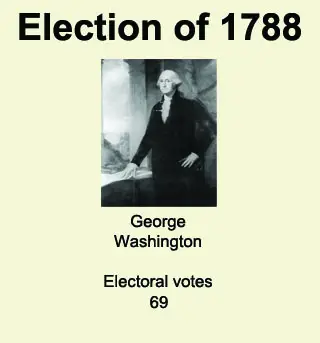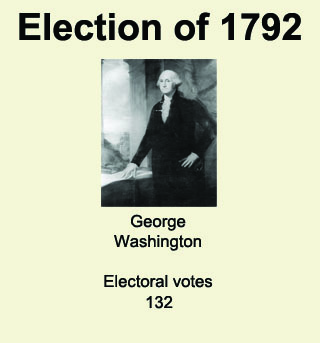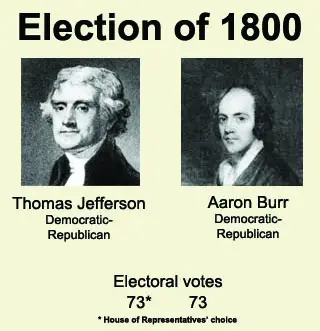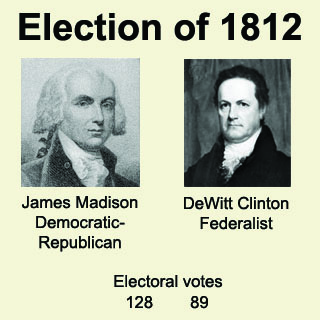The Election of the President Throughout U.S. History
Part 1: From the Beginning
The history of the election of the American Presidents is a story of popularity contests, wars, recessions and depressions, assassinations, great changes in the culture of the country, and many other factors. From humblest beginnings, the office of the President has grown into being acknowledged as "the leader of the free world." The Election of 1788 At the time, the practice was for every elector to cast two votes, and the candidate with the second-highest total was named Vice-president. America's first Vice-president was John Adams. Only 10 of the 13 Colonies participated in the election of 1788. North Carolina and Rhode Island had not yet ratified the Constitution, and the New York legislature had not put forward a final vote on who its electors would be. Still, there was no doubt who the winner would be: Washington, a war hero, was seen as the "Father of the Country." After the Revolutionary War, he had retired from public life. Other of the Founding Fathers convinced him to come out of retirement to again lead the country. The Election of 1792 Also in 1792, differences in political philosophy among some of America's Founding Fathers resulted in the founding of the country's first two political parties, the Federalists and the Democratic-Republicans. The Federalist Party, led by Alexander Hamilton, John Jay, and John Adams, believed in, among other things, a strong national government and a vibrant industrial economy. The Democratic-Republican Party, led by Thomas Jefferson and James Madison, believed, among other things, that the federal government shouldn't have too much power and that agrarian and rural elements were the backbone of the economy. This philosophical difference formed the basis of a long-running political dispute that shaped the growth of the country. Among the issues argued over during the months leading up to the 1796 election were the formation of the Bank of the United States and the passage of the Jay Treaty. The Election of 1796 Officially representing the Federalist Party, Adams squeaked out a win in the Electoral College, receiving 71 votes, to 68 for Democratic-Republican Thomas Jefferson. Thus, the Adams-Jefferson administration was the only one in the history of the country that featured an elected President and Vice-president from two different political parties. The philosophical split between the Federalists and the Democratic-Republicans was growing, with disagreements over the role of the federal government in people's lives and the role of the United States in the world being prominent topics of debate. The Election of 1800
The Constitution provided for this: So to the House it went. The country comprised 16 states at the time, and the President would be the candidate who got the vote of nine of those 16 states. Federalists controlled half of the state delegations, but those Representatives considered Jefferson, as the de facto leader of the opposition party, the one to defeat. Democratic-Republicans controlled the other eight states, and all of those delegations voted for Jefferson, since it seemed to everyone but Aaron Burr that Jefferson was intended to be the top man for the job. The deliberations continued for six days, during which 35 straight ballots showed eight votes for Jefferson and eight votes for Burr. Jefferson got some unexpected help from his arch-enemy, Alexander Hamilton, who chose to back Jefferson as the better of what he saw as two bad choices. Hamilton's efforts paid off as the state delegations of Maryland and Vermont changed their preference to Jefferson, giving him 10 votes and the presidency. The Election of 1804 Jefferson gained in popularity during his presidency, not the least because his authorization of the Louisiana Purchase ostensibly doubled the size of the country. Burr, meanwhile, dropped out of the public eye after killing Hamilton in a duel. When it came time for Jefferson to run for re-election, he chose a new vice-presidential candidate, New York Gov. George Clinton. Since the Twelfth Amendment made it clear who the presidential candidate was, Jefferson didn't need to worry about Clinton eclipsing him. Since he was so popular, Jefferson didn't need to worry about Charles Cotesworth Pinckney, the Federalist candidate, eclipsing him, either. Pinckney, the brother of Thomas Pinckney, who ran for president in 1796, managed to win only 14 of the 176 electoral votes. Jefferson won the other 162 and another term as President. The Election of 1808 About the only serious issue during the election campaign was New Englanders' opposition to the Embargo Act of 1807, which brought a halt to trade with Great Britain and France. The U.S. by this time had 17 states, and New England didn't enjoy a position as dominant as it had in earlier days. Madison proved a popular choice for most of the country, as he easily outdistanced C.C. Pinckney, who was again the Federalist standard-bearer, 122-47. Two things of note from this election: Clinton, Jefferson's Vice-president, continued in that role under Madison. It was the last election in which Virginia, which had been the state with the highest population, had the most electoral votes. The Census of 1810 resulted in New York's claiming the highest-population crown, which it kept until 1972. The Election of 1812 The U.S. declared war on Great Britain on June 12, 1812. As a result, Federalists called the conflict "Mr. Madison's War." Madison was again the Democratic-Republican candidate for President. His Vice-president, George Clinton, had died in office. Clinton's nephew, DeWitt Clinton, the lieutenant governor of new York, was the Federalist candidate. Despite the war (or perhaps because of it), Madison won re-election, garnering 128 electoral votes to Clinton's 89. |
|
Social Studies for Kids
copyright 2002–2025
David White


 Washington was re-elected in 1792, and Adams again received the second-highest number of votes. By this time, the other three original Colonies had ratified the Constitution and Kentucky and Vermont were now states. The national population had grown, and Washington's electoral vote total was 132.
Washington was re-elected in 1792, and Adams again received the second-highest number of votes. By this time, the other three original Colonies had ratified the Constitution and Kentucky and Vermont were now states. The national population had grown, and Washington's electoral vote total was 132. Washington had retired, this time for good. As was the practice in early days, 12 men declared themselves candidates for President. Adams, the two-time Vice-president, fancied himself for the top job.
Washington had retired, this time for good. As was the practice in early days, 12 men declared themselves candidates for President. Adams, the two-time Vice-president, fancied himself for the top job.  The result of Adams vs. Jefferson 2 was a reverse of the first, with Jefferson besting Adams in the electoral vote, 73 to 65. The problem for Jefferson was that among the other three candidates who stood for President was his fellow Democratic-Republican
The result of Adams vs. Jefferson 2 was a reverse of the first, with Jefferson besting Adams in the electoral vote, 73 to 65. The problem for Jefferson was that among the other three candidates who stood for President was his fellow Democratic-Republican  The events surrounding the election of 1800 resulted in the passage of the Twelfth Amendment, which, among other things, required presidential electors to specify which of their votes was for a presidential candidate and which vote was for a vice-presidential candidate.
The events surrounding the election of 1800 resulted in the passage of the Twelfth Amendment, which, among other things, required presidential electors to specify which of their votes was for a presidential candidate and which vote was for a vice-presidential candidate.  Jefferson enjoyed popularity throughout his second term as well but followed the two-term convention set out by George Washington and refused to run again. His Secretary of State, James Madison, took up the party leadership. Madison, well-known for his influential role during the Constitutional Convention, was initially an ally of Hamilton and had written some of the
Jefferson enjoyed popularity throughout his second term as well but followed the two-term convention set out by George Washington and refused to run again. His Secretary of State, James Madison, took up the party leadership. Madison, well-known for his influential role during the Constitutional Convention, was initially an ally of Hamilton and had written some of the  During Madison's presidency, the U.S. gained a state, Louisiana, and found itself increasingly hemmed in by European powers. Great Britain and France were fighting each other in the Napoleonic Wars, and both countries were ignoring America's neutrality proclamation and seizing American ships and sailors at sea. Britain also maintained forts in American territory and supported Native Americans fighting against American interests in the newly acquired Louisiana Territory.
During Madison's presidency, the U.S. gained a state, Louisiana, and found itself increasingly hemmed in by European powers. Great Britain and France were fighting each other in the Napoleonic Wars, and both countries were ignoring America's neutrality proclamation and seizing American ships and sailors at sea. Britain also maintained forts in American territory and supported Native Americans fighting against American interests in the newly acquired Louisiana Territory. 
